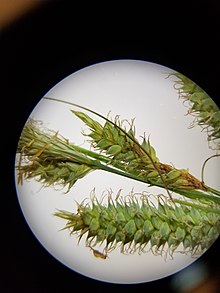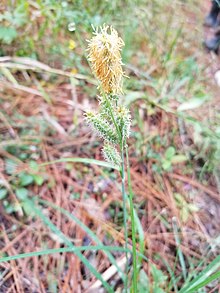Carex glaucescens is a perennial sedge that belongs to the family Cyperaceae.[1] The common name of this sedge is the southern waxy sedge due to the blue-grey, waxy appearance of the sheaths and fruits.[2][3] The term "glaucous" means "gleaming" or "grey" in Latin;[4] the specific epithet of C. glaucescens is derived from this term. Carex glaucescens is a native plant in North America and is an obligate wetland species in the Atlantic and Gulf Coastal Plains, Eastern Mountains and Piedmont, and the Great Plains.[1]
| Carex glaucescens | |
|---|---|

| |
| Scientific classification | |
| Kingdom: | Plantae |
| Clade: | Tracheophytes |
| Clade: | Angiosperms |
| Clade: | Monocots |
| Clade: | Commelinids |
| Order: | Poales |
| Family: | Cyperaceae |
| Genus: | Carex |
| Species: | C. glaucescens
|
| Binomial name | |
| Carex glaucescens Elliott
| |

Description
editCarex glaucescens is a graminoid,[1] meaning they have a grass-like[2] appearance. This species begins blooming in the early summer months, and begins developing fruits into the late summer months around July and August.[3][5] Carex glaucescens features a staminate spikelet at the top of the plant which fertilizes the pistillate spikelets below it.[3] The fruits are born on pendulous pistillate spikelets which are covered by translucent papilla, which gives the fruit sac its glaucous appearance.[3][5] Inside the fruit sac are ellipsoid achenes, the seed of the plant.[3]
References
edit- ^ a b c "CAGL5". USDA.
- ^ a b "Carex glaucescens". wildflower.org. LADY BIRD JOHNSON WILDFLOWER CENTER.
- ^ a b c d e "243. Carex glaucescens Elliott, Sketch Bot. S. Carolina. 2: 553. 1824". eflora.org. Missouri Botanical Garden, St. Louis, MO & Harvard University Herbaria, Cambridge, MA.
- ^ "glaucous". merriam-webster.com. Merriam Webster.
- ^ a b "Carex glaucescens". plants.ces.ncsu.edu. North Carolina State.